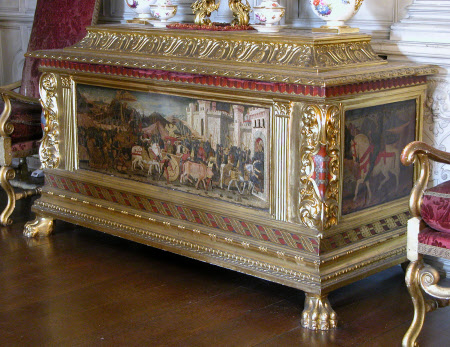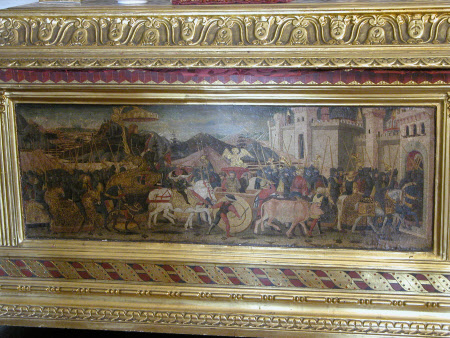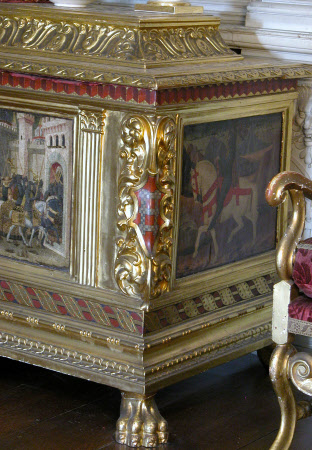Cassone
Giovanni di ser Giovanni Guidi (San Giovanni Valdarno 1406 - Florence 1486)
Category
Furniture
Date
circa 1870 - 1876
Materials
Wood, gesso, tempera, oil and gilding
Measurements
104.0 x 182.5 x 75.5 cm
Place of origin
Italy
Order this imageCollection
Knole, Kent
NT 129489
Summary
A carved, gilded and painted Italian coffer or cassone (rectangular lidded chests; plural: cassoni), on paw feet, made up before or in 1876, incorporating earlier woodwork, mounted on the front and sides with three painted panels attributed to Giovanni di Ser Giovanni Guidi, ‘Lo Scheggia’ (1406-1486) and studio, c.1460-70. The front panel depicts the triumph of a (presumably Roman) general, in armour and holding a baton, while the side panels are of single mounted soldiers, identified respectively by inscriptions as Marcus Curtius (‘Churzio Romano’) and Pompey the Great (‘Pompeo Magnio’). Cassoni of various types were made throughout Italy, but the Florentine tradition is the best documented. They are rare in British collections and range from the standard trunk or coffer, with rounded lid, to more elaborate confections. Three significant ones survive in the collections of the National Trust: the present one at Knole, one a Blickling, Norfolk (NT 354249) and one at Clivenden, Buckinghamshire (NT 765873). Cassoni were part of the paraphernalia of marriage, used by a bride mainly for the storage of fine textiles. Indeed, the processional theme of the paintings set into cassoni reflected their function as marriage chests representing the bride’s dowry. Cassoni were carried in the train of a bride to her new home. Just as the subjects of cassone paintings were often inspired by Greek and Roman Antiquity, so the carved and gilded woodwork was ‘all’antica’, reflecting the Renaissance revival of classical architecture and interior decoration.
Provenance
Knole and the majority of its furniture were accepted by HM Treasury in part payment of death duties and transferred to the National Trust in 1946.
Makers and roles
Giovanni di ser Giovanni Guidi (San Giovanni Valdarno 1406 - Florence 1486), painter
References
Thornton 1991: Peter Thornton, The Italian Renaissance Interior, 1400-1600, London 1991 Campbell 2009: Caroline Campbell, Love and Marriage in Renaissance Florence: The Courtauld Wedding Chests (ex. cat.), London 2009 Rowell 2015: Christopher Rowell, 'Florentine Cassoni at Blickling, Knole and Cliveden', Furniture History (2015): 21-49



